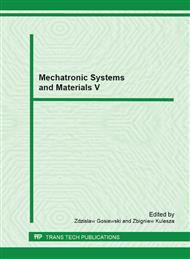[1]
C. Llena-Puy, The role of saliva in maintaining oral health and as aid to diagnosis, Med Oral Patol Oral Cir Bucal, 11 (2006) E: 449-55.
Google Scholar
[2]
M. E Brosky, The role of saliva In oral health. Strategies for prevention and management of xerostomia, J Support Oncol, 5 (2007) 215-225.
Google Scholar
[3]
L.S. Bruno, X. Li, L. Wang, R.V. Soares, A.C. Siqueira, F.G. Oppenheim, R.F. Troxler, G.D. Offner, Two-hybrid analysis of human salivary mucin MUC7 interactions, Biochimica et Biophysica Acta, 1746 (2005) 65-72.
DOI: 10.1016/j.bbamcr.2005.08.007
Google Scholar
[4]
H.M. Kelly, P.B. Deasy, M. Busquet, A.A. Torrance, Bioadhesive, rheological, lubricant and other aspects of an oral gel formulation intended for the treatment of xerostomia, International Journal of Pharmaceutics, 278 (2004) 391-406.
DOI: 10.1016/j.ijpharm.2004.03.022
Google Scholar
[5]
E.S. Reeh, W.H. Douglas, M.J. Levine, Lubrication of saliva substitutes at enamel-to-enamel contacts in an artificial mouth, J Prosthet Dent, 75 (1996) 649-56.
DOI: 10.1016/s0022-3913(96)90251-6
Google Scholar
[6]
K. Wang, The use of titanium for medical applications in the USA, Materials Science&EngineeringA 213 (1996) 134-137.
Google Scholar
[7]
http: /www. rhein83. com. /ENG/prodotti. php?IDM=21&TMP=Grafica&IDS=0&cat=1&pro=9.
Google Scholar
[8]
K. Kawasaki, M. Kambara, H. Matsumura, W. Norde, A comparison of the adsorption of saliva proteins and some typical proteins onto the surface of hydroxyapatite, Collloids and Surfaces B, 32 (2003) 321-334.
DOI: 10.1016/j.colsurfb.2003.07.001
Google Scholar
[9]
H. Badawi, R.D. Evans, M. Wilson, D. Ready, J.H. Noar, J. Pratten, The effect of orthodontic bonding materials on dental plaque accumulation and composition in vitro, Biomaterials, 24 (2003) 3345-3350.
DOI: 10.1016/s0142-9612(03)00166-2
Google Scholar
[10]
L. Wong, C.H. Sissions, A comparison of human dental plaque microcosm biofilms grown in an undefined medium and a chemically defined artificial saliva, Archives of Oral Biology, 46 (2001) 477-486.
DOI: 10.1016/s0003-9969(01)00016-4
Google Scholar
[11]
R. Maheshwari, A. Dhathathreyan, Mucin at solution/air and solid/solution interfaces, Journal of Colloid and Interface Science, 293 (2006) 263-269.
DOI: 10.1016/j.jcis.2005.06.058
Google Scholar
[12]
D. Steinberg, A. Klinger, D. Kohavi, M.N. Sela, Adsorption of human salivary proteins to titanium powder. I. Adsorption of human salivary albumin, Biomaterials 16 (1995) 1339-1343.
DOI: 10.1016/0142-9612(95)91050-9
Google Scholar
[13]
D. Ivarsson, M. Wahlgren, Comparison of in vitro methods of measuring mucoadhesion: ellipsometry, tensile strength and rheological measurements, Colloids and Surfaces B: Biointerfaces 92 (2012) 353-359.
DOI: 10.1016/j.colsurfb.2011.12.020
Google Scholar
[14]
M. M. Bradford, Rapid and sensitive method for the quantitation of microgram quantities of protein utilizing the principle of protein-dye binding, Anal. Biochem. 72 (1976) 248–254.
DOI: 10.1016/0003-2697(76)90527-3
Google Scholar
[15]
J.A. Lori, A.J. Nok, Mechanism of adsorption of mucin to titanium in vitro. Biomed Mater. Eng 14 (2004) 557-63.
Google Scholar


